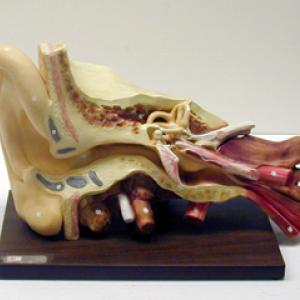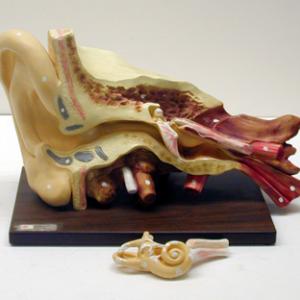College of Liberal Arts & Sciences
3C10.10 - Model of the Human Ear
See also 3C10.10 in Physics of the Human Body.
No advanced notice required. Parts of the ear are numbered and an explanation of these parts can be found in the file.
- Lisa Stinken, Stefan Heusler, and Hans-Otto Carmesin, "At the Limit: Introducing Energy with Human Senses", TPT, Vol. 54, #9, Dec. 2016, p. 552.
- Neal P. Rowell, "The Response of the Ear", TPT, Vol. 18, #7, Oct. 1980, p. 531.
- F. Milder, "Apparatus for Demonstrating Resonances of the Inner Ear", TPT, Vol. 16, #7, Oct. 1978, p. 503.
- Richard J. Fitzgerald, "Restoring Hearing with Light", Physics Today, Vol. 71, #8, Aug. 2018, p. 68.
- Mario Svirsky, "Cochlear Implants and Electronic Hearing", Physics Today, Vol. 70, #8, Aug. 2017, p. 52.
- R. Mark Wilson, "Artificial Eardrums Get Real", Physics Today, Vol. 68, #7, July 2015, p. 14.
- "A Neural Window Into the Cochlea", Physics Today, Vol. 65, #10, Oct. 2012, p. 96.
- Mark Wilson, "Interferometry Data Challenge Prevailing View of Wave Propagation in the Cochlea", Physics Today, Vol. 61, #4, Apr. 2008, p. 26.
- Joseph D. Ciparick, "The Ear and the Microphone", The Science Teacher, Vol. 55, #9, Dec. 1988, p. 46.
- R. W. Pohl, "17. The Sense of Hearing", Physical Principles of Mechanics and Acoustics, p. 309.
- Pat Murphy, Ellen Macaulay, and the staff of the Exploratorium, "Your Ears", Exploratopia, p. 17.
- "Nose & Ears", Uncle John's Bathroom Reader, p. 48.
- Jearl Walker, "3.30, Noise-Induced Hearing Loss", The Flying Circus of Physics Ed. 2, p. 158.
- Jearl Walker, "3.28, Sound Emitted by the Ears", The Flying Circus of Physics Ed. 2, p. 157.
- Janice VanCleave, "Tilt", and "Receivers", The Human Body for Every Kid, p. 113 - 120, 121 - 127.
- Neil. A. Downie, "Sounds Interesting", Ink Sandwiches, Electric Worms and 37 Other experiments for Saturday Science, p. 49.
- Tom Petruzzellis, "Sound Energy", Electronic Sensors for the Evil Genius, p. 1.
- Curt Suplee, "Sounds of a Lifetime", Everyday Science Explained, National Geographic, p. 252 - 253.
- Janice VanCleave, "79. Spinning", Janice VanCleave's 201 Awesome, Magical, Bizarre, & Incredible Experiments, p. 43.
- Don Herbert and Hy Ruchlis, "Your Senses", Mr. Wizard's 400 Experiments in Science, p. 9 - 12.
- Sarah Scoles, "Now Here This", Popular Science, Winter 2019, p. 42.
- Danavyn Coffey, "The Secret Life of Earwax", Popular Science, Winter 2019, p. 108.
- Sara Stein, "Noises - What Strikes The Ear", The Science Book, p. 173.
- Joseph Frick, "#153 - Model of the Ear", Physical Technics: Or, Practical Instructions for Making Experiments in Physics and the Construction of Physical Apparatus with the Most Limited Means", p. 179.
Disclaimer: These demonstrations are provided only for illustrative use by persons affiliated with The University of Iowa and only under the direction of a trained instructor or physicist. The University of Iowa is not responsible for demonstrations performed by those using their own equipment or who choose to use this reference material for their own purpose. The demonstrations included here are within the public domain and can be found in materials contained in libraries, bookstores, and through electronic sources. Performing all or any portion of any of these demonstrations, with or without revisions not depicted here entails inherent risks. These risks include, without limitation, bodily injury (and possibly death), including risks to health that may be temporary or permanent and that may exacerbate a pre-existing medical condition; and property loss or damage. Anyone performing any part of these demonstrations, even with revisions, knowingly and voluntarily assumes all risks associated with them.

